Tae Hyun Kim
IDF: Iterative Dynamic Filtering Networks for Generalizable Image Denoising
Aug 27, 2025Abstract:Image denoising is a fundamental challenge in computer vision, with applications in photography and medical imaging. While deep learning-based methods have shown remarkable success, their reliance on specific noise distributions limits generalization to unseen noise types and levels. Existing approaches attempt to address this with extensive training data and high computational resources but they still suffer from overfitting. To address these issues, we conduct image denoising by utilizing dynamically generated kernels via efficient operations. This approach helps prevent overfitting and improves resilience to unseen noise. Specifically, our method leverages a Feature Extraction Module for robust noise-invariant features, Global Statistics and Local Correlation Modules to capture comprehensive noise characteristics and structural correlations. The Kernel Prediction Module then employs these cues to produce pixel-wise varying kernels adapted to local structures, which are then applied iteratively for denoising. This ensures both efficiency and superior restoration quality. Despite being trained on single-level Gaussian noise, our compact model (~ 0.04 M) excels across diverse noise types and levels, demonstrating the promise of iterative dynamic filtering for practical image denoising.
Harnessing Meta-Learning for Controllable Full-Frame Video Stabilization
Aug 26, 2025Abstract:Video stabilization remains a fundamental problem in computer vision, particularly pixel-level synthesis solutions for video stabilization, which synthesize full-frame outputs, add to the complexity of this task. These methods aim to enhance stability while synthesizing full-frame videos, but the inherent diversity in motion profiles and visual content present in each video sequence makes robust generalization with fixed parameters difficult. To address this, we present a novel method that improves pixel-level synthesis video stabilization methods by rapidly adapting models to each input video at test time. The proposed approach takes advantage of low-level visual cues available during inference to improve both the stability and visual quality of the output. Notably, the proposed rapid adaptation achieves significant performance gains even with a single adaptation pass. We further propose a jerk localization module and a targeted adaptation strategy, which focuses the adaptation on high-jerk segments for maximizing stability with fewer adaptation steps. The proposed methodology enables modern stabilizers to overcome the longstanding SOTA approaches while maintaining the full frame nature of the modern methods, while offering users with control mechanisms akin to classical approaches. Extensive experiments on diverse real-world datasets demonstrate the versatility of the proposed method. Our approach consistently improves the performance of various full-frame synthesis models in both qualitative and quantitative terms, including results on downstream applications.
LAN: Learning to Adapt Noise for Image Denoising
Dec 14, 2024



Abstract:Removing noise from images, a.k.a image denoising, can be a very challenging task since the type and amount of noise can greatly vary for each image due to many factors including a camera model and capturing environments. While there have been striking improvements in image denoising with the emergence of advanced deep learning architectures and real-world datasets, recent denoising networks struggle to maintain performance on images with noise that has not been seen during training. One typical approach to address the challenge would be to adapt a denoising network to new noise distribution. Instead, in this work, we shift our focus to adapting the input noise itself, rather than adapting a network. Thus, we keep a pretrained network frozen, and adapt an input noise to capture the fine-grained deviations. As such, we propose a new denoising algorithm, dubbed Learning-to-Adapt-Noise (LAN), where a learnable noise offset is directly added to a given noisy image to bring a given input noise closer towards the noise distribution a denoising network is trained to handle. Consequently, the proposed framework exhibits performance improvement on images with unseen noise, displaying the potential of the proposed research direction. The code is available at https://github.com/chjinny/LAN
Deep Variational Bayesian Modeling of Haze Degradation Process
Dec 04, 2024



Abstract:Relying on the representation power of neural networks, most recent works have often neglected several factors involved in haze degradation, such as transmission (the amount of light reaching an observer from a scene over distance) and atmospheric light. These factors are generally unknown, making dehazing problems ill-posed and creating inherent uncertainties. To account for such uncertainties and factors involved in haze degradation, we introduce a variational Bayesian framework for single image dehazing. We propose to take not only a clean image and but also transmission map as latent variables, the posterior distributions of which are parameterized by corresponding neural networks: dehazing and transmission networks, respectively. Based on a physical model for haze degradation, our variational Bayesian framework leads to a new objective function that encourages the cooperation between them, facilitating the joint training of and thereby boosting the performance of each other. In our framework, a dehazing network can estimate a clean image independently of a transmission map estimation during inference, introducing no overhead. Furthermore, our model-agnostic framework can be seamlessly incorporated with other existing dehazing networks, greatly enhancing the performance consistently across datasets and models.
* Published in CIKM 2023, 10 pages, 9 figures
Harnessing Meta-Learning for Improving Full-Frame Video Stabilization
Mar 06, 2024Abstract:Video stabilization is a longstanding computer vision problem, particularly pixel-level synthesis solutions for video stabilization which synthesize full frames add to the complexity of this task. These techniques aim to stabilize videos by synthesizing full frames while enhancing the stability of the considered video. This intensifies the complexity of the task due to the distinct mix of unique motion profiles and visual content present in each video sequence, making robust generalization with fixed parameters difficult. In our study, we introduce a novel approach to enhance the performance of pixel-level synthesis solutions for video stabilization by adapting these models to individual input video sequences. The proposed adaptation exploits low-level visual cues accessible during test-time to improve both the stability and quality of resulting videos. We highlight the efficacy of our methodology of "test-time adaptation" through simple fine-tuning of one of these models, followed by significant stability gain via the integration of meta-learning techniques. Notably, significant improvement is achieved with only a single adaptation step. The versatility of the proposed algorithm is demonstrated by consistently improving the performance of various pixel-level synthesis models for video stabilization in real-world scenarios.
Efficient Model Agnostic Approach for Implicit Neural Representation Based Arbitrary-Scale Image Super-Resolution
Nov 20, 2023Abstract:Single image super-resolution (SISR) has experienced significant advancements, primarily driven by deep convolutional networks. Traditional networks, however, are limited to upscaling images to a fixed scale, leading to the utilization of implicit neural functions for generating arbitrarily scaled images. Nevertheless, these methodologies have imposed substantial computational demands as they involve querying every target pixel to a single resource-intensive decoder. In this paper, we introduce a novel and efficient framework, the Mixture of Experts Implicit Super-Resolution (MoEISR), which enables super-resolution at arbitrary scales with significantly increased computational efficiency without sacrificing reconstruction quality. MoEISR dynamically allocates the most suitable decoding expert to each pixel using a lightweight mapper module, allowing experts with varying capacities to reconstruct pixels across regions with diverse complexities. Our experiments demonstrate that MoEISR successfully reduces up to 73% in floating point operations (FLOPs) while delivering comparable or superior peak signal-to-noise ratio (PSNR).
NoiseTransfer: Image Noise Generation with Contrastive Embeddings
Jan 31, 2023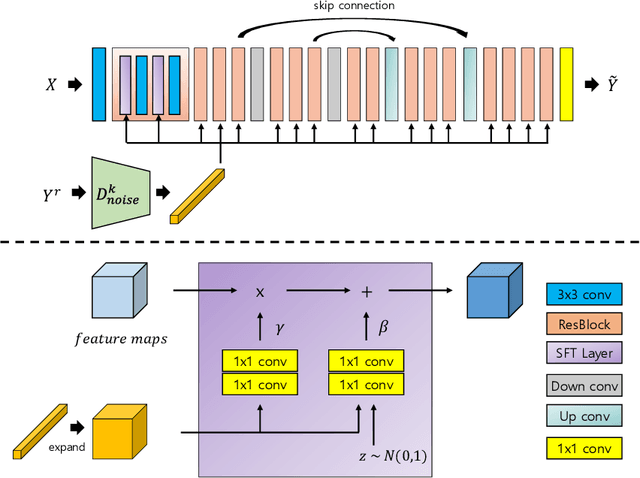

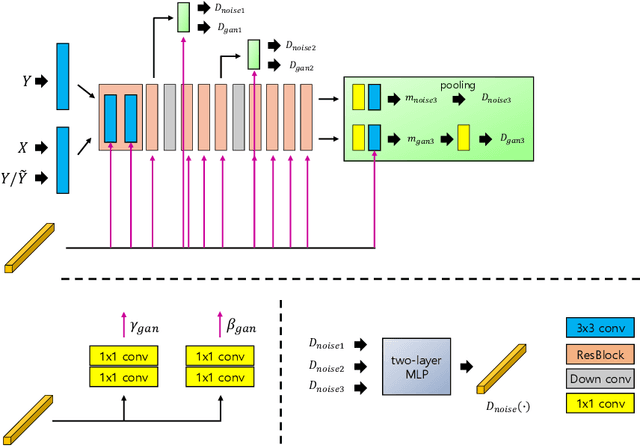

Abstract:Deep image denoising networks have achieved impressive success with the help of a considerably large number of synthetic train datasets. However, real-world denoising is a still challenging problem due to the dissimilarity between distributions of real and synthetic noisy datasets. Although several real-world noisy datasets have been presented, the number of train datasets (i.e., pairs of clean and real noisy images) is limited, and acquiring more real noise datasets is laborious and expensive. To mitigate this problem, numerous attempts to simulate real noise models using generative models have been studied. Nevertheless, previous works had to train multiple networks to handle multiple different noise distributions. By contrast, we propose a new generative model that can synthesize noisy images with multiple different noise distributions. Specifically, we adopt recent contrastive learning to learn distinguishable latent features of the noise. Moreover, our model can generate new noisy images by transferring the noise characteristics solely from a single reference noisy image. We demonstrate the accuracy and the effectiveness of our noise model for both known and unknown noise removal.
Learning Task Agnostic Temporal Consistency Correction
Jun 08, 2022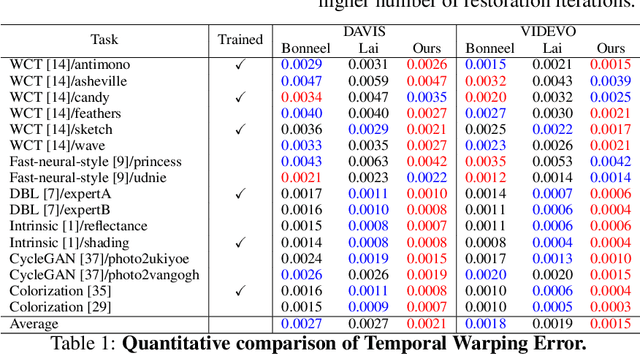
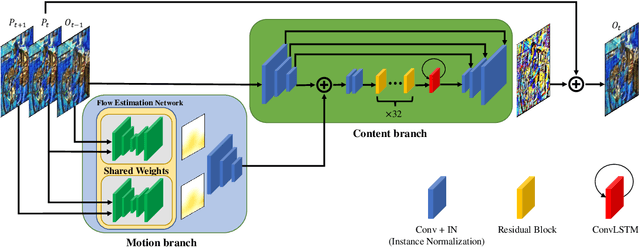

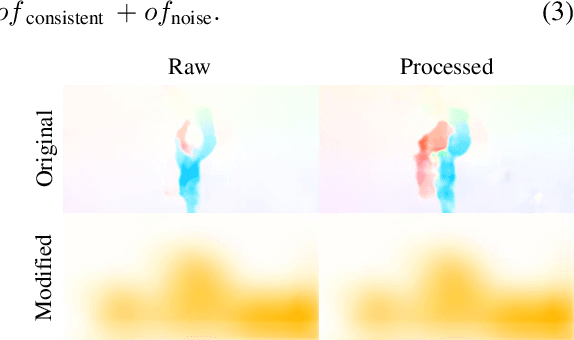
Abstract:Due to the scarcity of video processing methodologies, image processing operations are naively extended to the video domain by processing each frame independently. This disregard for the temporal connection in video processing often leads to severe temporal inconsistencies. State-of-the-art techniques that address these inconsistencies rely on the availability of unprocessed videos to siphon consistent video dynamics to restore the temporal consistency of frame-wise processed videos. We propose a novel general framework for this task that learns to infer consistent motion dynamics from inconsistent videos to mitigate the temporal flicker while preserving the perceptual quality for both the temporally neighboring and relatively distant frames. The proposed framework produces state-of-the-art results on two large-scale datasets, DAVIS and videvo.net, processed by numerous image processing tasks in a feed-forward manner. The code and the trained models will be released upon acceptance.
Rich CNN-Transformer Feature Aggregation Networks for Super-Resolution
Mar 16, 2022

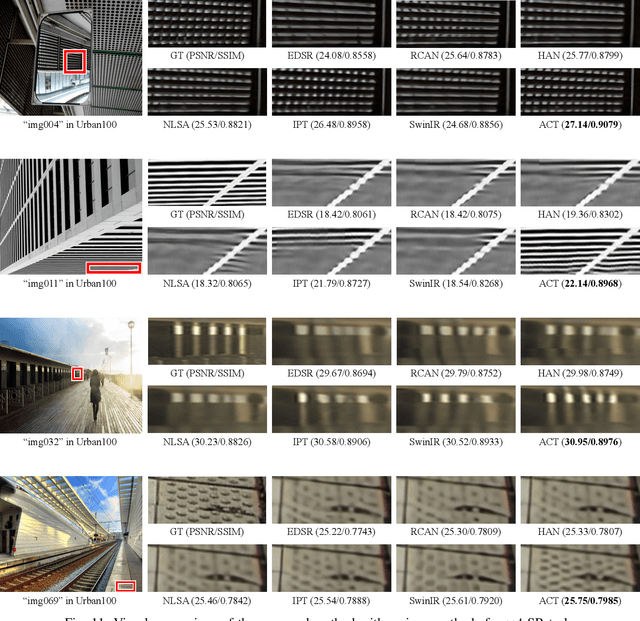

Abstract:Recent vision transformers along with self-attention have achieved promising results on various computer vision tasks. In particular, a pure transformer-based image restoration architecture surpasses the existing CNN-based methods using multi-task pre-training with a large number of trainable parameters. In this paper, we introduce an effective hybrid architecture for super-resolution (SR) tasks, which leverages local features from CNNs and long-range dependencies captured by transformers to further improve the SR results. Specifically, our architecture comprises of transformer and convolution branches, and we substantially elevate the performance by mutually fusing two branches to complement each representation. Furthermore, we propose a cross-scale token attention module, which allows the transformer to efficiently exploit the informative relationships among tokens across different scales. Our proposed method achieves state-of-the-art SR results on numerous benchmark datasets.
Restore from Restored: Single-image Inpainting
Oct 25, 2021



Abstract:Recent image inpainting methods have shown promising results due to the power of deep learning, which can explore external information available from the large training dataset. However, many state-of-the-art inpainting networks are still limited in exploiting internal information available in the given input image at test time. To mitigate this problem, we present a novel and efficient self-supervised fine-tuning algorithm that can adapt the parameters of fully pre-trained inpainting networks without using ground-truth target images. We update the parameters of the pre-trained state-of-the-art inpainting networks by utilizing existing self-similar patches (i.e., self-exemplars) within the given input image without changing the network architecture and improve the inpainting quality by a large margin. Qualitative and quantitative experimental results demonstrate the superiority of the proposed algorithm, and we achieve state-of-the-art inpainting results on publicly available benchmark datasets.
 Add to Chrome
Add to Chrome Add to Firefox
Add to Firefox Add to Edge
Add to Edge